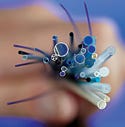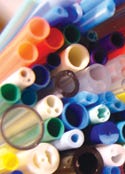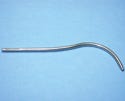Tube Manufacturing Made Easier
COVER STORY: TUBING
September 1, 2007
|
Polyimide materials are among those often used in device manufacturing. Photo courtesy of MicroLumen Inc. (Tampa, FL). |
Many design decisions affect how easy or difficult it will be to manufacture a tubing product. But often, designers aren't aware that their choices can lead to unavoidable manufacturing difficulties.
In many cases, design decisions lead to hard-to-meet requirements that aren't actually needed for the tubes to perform their intended functions. Such decisions relate to, among other things, the choice of materials, the configuration of part features, and the dimensions and tolerances assigned to parts.
So whether they do it in-house or with the help of their manufacturing partners, medical device firms can save significant amounts of time and money by evaluating the manufacturability of their tubing designs and modifying or eliminating requirements that unnecessarily complicate the manufacturing process.
Material Questions
For each tubing application, manufacturability evaluation should be performed. By asking—and honestly answering—a number of key questions in the area of materials OEMs can better assess their critical needs.
Are we making extraordinary demands of our tubing material? If so, manufacturing personnel may find it difficult if not impossible to meet those requirements. “Some design engineers want everything. But one plastic can't provide all that they want,” says Krissi Heard, who handles technical sales for MicroLumen Inc. (Tampa, FL). The company manufactures custom polyimide tubing primarily for minimally invasive medical devices. When dealing with overly demanding designers, MicroLumen tries to get them to zero in on their most critical requirements to see whether these can be met by polyimide.
|
In many cases, design decisions lead to hard-to-meet requirements that aren't actually needed for the tubes to perform their intended functions. (Above) Braid-reinforced polyimide tubing such as this from MicroLumen (Tampa, FL) provides increased column strength and torque transmission. |
Do we have good reasons for choosing that material for our product? Many medical device firms now want tubing made of exotic metals such as platinum, nickel alloy, and titanium, according to Vin Altruda, vice president of manufacturing for Popper Precision Instruments Inc. (Lincoln, RI). His company fabricates metal tubing for applications such as analysis equipment and gluing machines used in medical device production. But production can be more difficult when designers choose something other than standard metals such as stainless steel, which is by far the most common tubing material Popper works with in its fabrication operations.
For one thing, Altruda says, manufacturers may have a hard time finding sources for unconventional metals. In addition, he notes, manufacturing personnel and operations that deal mainly with stainless steel may find it difficult to process other materials. “As our customers go to more exotic materials, we have to learn how to process them,” Altruda says. “And many times, we can't do it with the equipment we have.”
According to Altruda, titanium is the most popular of the new alternatives to stainless steel. But Popper has found titanium harder to work with than stainless steel. In fact, the firm has yet to figure out how to perform some of its normal fabrication operations on titanium. So Altruda and his colleagues will sometimes ask customers if stainless steel can be substituted for titanium in their designs.
As for plastic tubes, many designers choose a material because they've used it before and know it—not because they've determined that it's the best plastic for their current product, maintains Mark Saab. He is president of Advanced Polymers Inc. (Salem, NH), which manufactures plastic tubing and medical balloons for dilation procedures. As a result, the chosen plastic may be difficult to obtain, which can slow the manufacturing process. Or it may only be produced by a supplier whose materials often have inconsistent properties.
|
It is important to choose the material that is best for the product. Photo courtesy of Advanced Polymers Inc. (Salem, NH). |
“We've seen a lot of batch-to-batch variation in some materials from certain suppliers,” Saab says. “That makes it harder for us to run the materials and harder to meet the customer's dimensional requirements.”
Is that additive necessary? Saab's customers often ask that their tubing include a barium sulfate filler for radiopacity. But such fillers can't be added in Saab's manufacturing machines. Instead, he says, they must be mixed into the tubing material in a special compounding step, which adds a considerable amount of time and expense to the manufacturing process.
Generally speaking, Saab says, Advanced Polymers can extrude a Pebax tube in two weeks. But if a customer wants a Pebax tube with 20% barium sulfate, there might be three or four weeks of lead time spent waiting for a compounder to acquire the required materials, mix them, and deliver the finished product. To make matters worse, he adds, the custom compound might double the cost of the job.
So what are the reasons for the addition of this troublesome filler? “Some people say that they need it because marketing asked for it. Other people say they don't know why they need it, but a competitor's product has it, so they want it. But many times, the competitor's product is 10 or 15 years old and [the radiopacity] isn't important anymore. So when we get done talking to them, they'll say, ‘I guess we don't need it,'” says Saab, who has talked many customers out of adding radiopaque fillers to their products.
Can you get by without a special color? According to Saab, many device manufacturers want tubing of a specific color—to match their corporate colors or for some other reason. But when material with colorant is extruded into a thin-wall tube, the resulting color will look much lighter than the colorant did to begin with. If a customer insists on the darker shade that was originally requested, the result can be a time-consuming trial-and-error process. It can take time to come up with a formulation that will produce the desired color when extruded. In development, this process can add weeks to the lead time and increase the cost of an extrusion run by 50–100%, Saab says.
|
Platinum-cured silicone tubing can be molded and extruded into a variety of components. Photo courtesy of Helix Medical Inc. (Carpinteria, CA). |
Today, however, Saab extrudes many tubes that are clear or a natural color. The designers of these products aren't concerned about color because the tubes, which are used in tiny devices, are so small that “you can hardly see the product anyway,” he says.
How well will those two materials work together? Today, designers often integrate other products into their tubes, notes Sean McPherson, vice president of marketing for Helix Medical Inc. (Carpinteria, CA), an extruder of silicone tubing. For example, some of the company's customers want silicone tubes with electrical wires inside the walls. Used for communication, the wires carry signals in diagnostic or monitoring systems.
On the downside, dual-material tubes can create serious manufacturing problems. For instance, McPherson says, some types of wire have so much shape memory that they'll deform or even push through the walls of silicone tubes being created around them. But other wires work better, so designers of these products must know enough to pick the right type or seek help from contract manufacturing partners knowledgeable about silicone extrusion.
Silicone is also being combined with Teflon and other materials to create tubes with multiple properties. Designers of these tubes must be sure that whatever material is paired with silicone can take the 350°–450°F temperatures that silicone is exposed to during its curing process, McPherson notes. In addition, he says, they must be sure the other material will bond to silicone or can be attached to it using a special coating or pretreatment.
Sizing Up Part Features
In addition to material-related matters, designers should carefully consider the manufacturability of their tubing features. Important questions in this area should encompass both physical and cost considerations.
Is this bend radius too small? Stainless-steel hypodermic tubing kinks if the radius of a bend isn't at least twice the outside diameter of the tube, says Altruda.
|
It takes time to develop a formulation that produces the desired color when extruded. Photo courtesy of Advanced Polymers. |
Is that too much reduction? Sometimes, medical device designers want to reduce the diameter of a piece of metal tubing somewhere along its length. For example, Altruda says, a designer might want to reduce the diameter at the end of a tube to create drops of a certain size. Popper can do this using a rotary swaging operation that proportionally reduces the outside and inside diameters at one end of a tube by running it through a set of dies. But some customers ask for reductions that can't be accomplished using normal manufacturing operations. Although it may be possible to produce the reductions using unconventional processes, “we'll talk to them to find out whether they can live with something that's more manufacturable,” Altruda says.
Why do we want sharp corners? Design drawings of multilumen parts often show sharp corners on D- and crescent-shaped lumens, says Michael Badera. He is president of Precision Extrusion Inc. (Glens Falls, NY), which designs and manufactures custom plastic tubing for the medical device industry. But in a normal extrusion process, Badera notes, plastic doesn't flow in a way that allows the creation of sharp corners. To produce these features, he says, manufacturers must embark on a complicated process that includes difficult tooling design.
Why do tube designs include sharp corners? Designers may think they allow a little more flow through the tube than rounded-off corners, Badera says. “But in reality, there won't be good flow through those areas anyway. So it looks like they're giving up some real estate [by rounding off the corners], but I don't believe it's actually affecting the flow.”
Are complex shapes worth the trouble? Under certain circumstances, tooling can cost five times more than it normally would for silicone extrusion, says Chris Hamming, a manufacturing engineer at Helix Medical. This can happen when designs call for two features. One is when lumens are D-shaped, curved, oval, square, or some other shape that isn't circular. The other is when designers need arrangements of circular lumens that aren't in a symmetric pattern, he explains. “Setup can go from a typical half hour to half a day or half a shift,” he says. “That's the worst case, but we see it.”
In addition, compared with normal geometries, extrusion of complex or irregular tubing geometries can be more seriously affected by lot-to-lot variations in silicone materials. “We may have all our parameters dialed in,” Hamming says. “But if we go to run the same part with the same die and mandrel three months later, we find ourselves having to do a lot of tweaking.”
|
Custom tubes, like these from Precision Extrusion Inc. (Glens Falls, NY), can be created for medical device manufacturers. |
Are we willing to pay the price for very small features? Hamming says that creation of internal silicone tube features measuring 0.007 in. or less can double or triple lead time. It can also cost up to four times more than it does to produce larger silicone features, according to McPherson.
The Big Question
Of all the manufacturability questions that can be asked about a tubing design, perhaps none is as important as this one: How manufacturing-friendly are the design dimensions and tolerances?
Among tube designers, Hamming says, “there's a tendency to overspec—to impose minimum wall thicknesses and small tolerance ranges on features that aren't critical.” When designers pile on features, requirements, and restrictions in a single tube design, he adds, manufacturers can “end up with almost nothing left to work with. The part has to be almost perfect.”
Badera thinks overly tight dimensional restrictions can be attributed to a lack of knowledge about plastics. “With fabricated parts made of metal, you can grind and drill and ream very precisely—in some cases down to tens of thousandths of an inch,” he says. “And a lot of designers think plastic tubing is just like metal tubing—that you can specify things out to four decimal places and hold tolerances of plus or minus almost nothing. Unfortunately, plastic extrusion doesn't work that way.”
Sometimes, Badera's customers make his job even more difficult by presenting him with what he calls “conflicting tolerances.” For example, consider a tube with an outside diameter measuring 4 mm, a 1-mm wall thickness, and a 2-mm inner lumen. If the specification for this tube calls for a tolerance of ±0.1 mm for the outside diameter and ±0.05 mm on the inner lumen and the top and bottom walls, an extruded tube wouldn't meet the OD specification if all the component dimensions were at the high end of their tolerance ranges. (The tube would require an OD of 4.15 mm versus the specified tolerance of 4 mm + 0.1 mm.)
|
Metal tubing can be used in analysis equipment and machines used in medical device production. Photo courtesy of Popper Precision Instruments Inc. (Lincoln, RI). |
In this case, Badera says, “[the supplier is] not given room to work with all the specs in their full range. It has to work tighter than the ±0.05 mm tolerances or the OD will be out of spec.”
Besides making manufacturing extremely difficult, overly tight tolerances can drive down the yield of the production process. “If we're asked to hold a tolerance of ±0.001 in., we have to throw away everything that's outside that spec, which could be 50% of the product being extruded,” Saab says. “I've seen jobs run at 50% yield in production that could have run at 90–100% yield if the tolerance had been opened up by 0.001 in.”
Hearing from the Manufacturer
So before they dig in their heels on dimensions and tolerances, designers might benefit from a talk with their manufacturers. For example, at no additional cost, Precision Extrusion will review specifications with customers to help them determine which items are really important and which are not. “Most of the time when we talk to customers, we find that they can loosen up the tolerances on several dimensions,” Badera says. “They just hadn't thought about what's really critical to their designs.”
If Altruda and his colleagues spot tolerances that will be difficult to hold, they sometimes point out to customers that opening up the tolerances will make their products less expensive to manufacture. In such cases, most customers allow tolerance changes, Altruda reports.
When Helix quotes jobs with tight tolerances, the company provides customers with options that show how much they can save by relaxing certain tolerances. “We're usually pretty successful when we show them that there's a big [cost] difference between what they're asking for and what they might really need,” McPherson reports.
Despite the obvious advantages for both parties, however, manufacturability discussions between tube designers and manufacturers seem to be the exception rather than the rule. Why aren't they more common? McPherson speculates that some designers may not solicit outside manufacturability input because it adds to design time, while others may be unwilling to share design information with another firm. Badera attributes it in part to procedures at large firms that tend to produce designs that are “pretty much set in stone.”
|
It is important to choose a tubing because it's optimal for the intended product. Photo of extruded tubing courtesy of Advanced Polymers Inc. (Salem, NH). |
If many tube manufacturers had their way, designers would come to them early and often for manufacturability input. For example, Badera says, “A customer might come to us with his first idea and say, ‘What do you think?' And we would say, ‘This wall is too thin, this one is too thick, and your tolerances here are too tight.' Then the customer would come back to us with second and third iterations, and the two of us would keep working through these issues until it got to the point where we'd say, ‘That's very doable,' and the customer would say, ‘Good. I think it will work for me.'”
For example, Radiant Medical Inc. (Redwood City, CA) enlisted Advanced Polymers's help during the development of Reprieve, Radiant's device for controlling patient temperature. The product includes a heat-exchange balloon catheter that maintains a small profile during placement in the patient's body and then expands to maximize heat transfer between the blood and the catheter. The balloon catheter includes three helical lobes that exchange heat with blood flowing over their surfaces. Sterile saline circulating through the balloon catheter is warmed or cooled as necessary to produce the desired patient temperature. This heat-exchange mechanism allows the saline to change the temperature of blood without actually coming in contact with it.
Radiant collaborated with Advanced Polymers to create the balloon catheter. “We involved them basically from the get-go,” recalls Ben Brian, Radiant's vice president of engineering. “We drew some designs literally on the back of a napkin and said, ‘What do you think?'” During the development process, the team reduced the catheter's lobes from seven to three so that the job could be completed within Radiant's time frame. The process “was very iterative and collaborative, with good theoretical analysis on our end and good practical analysis on their end.”
What's the lesson from this successful partnership? “It's critical to involve the supplier and not just throw a specification over the wall,” Brian says. “Collaboration is the key to manufacturability.”
William Leventon is a freelance writer based in Somers Point , NJ , who frequently contributes to MD&DI.
Copyright ©2007 Medical Device & Diagnostic Industry
About the Author(s)
You May Also Like










